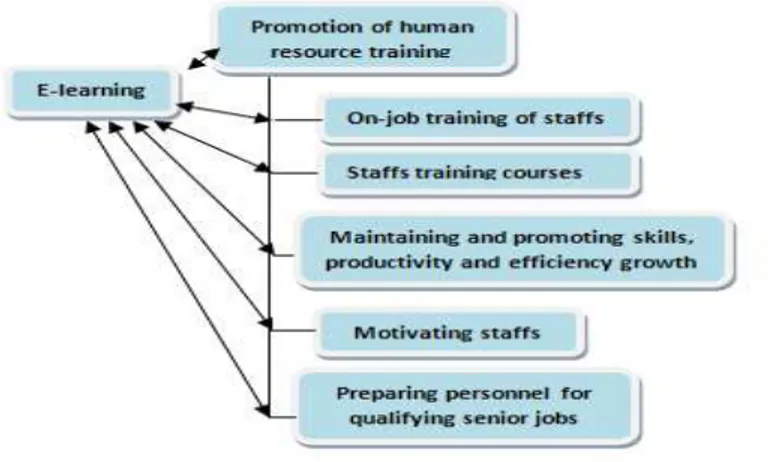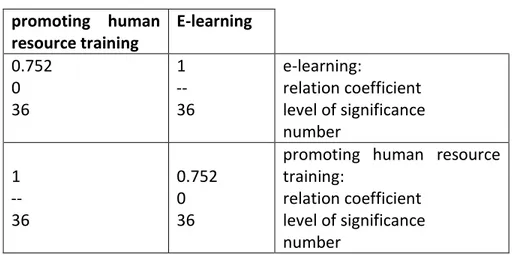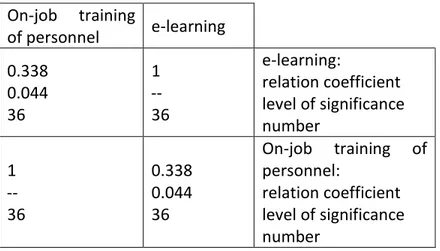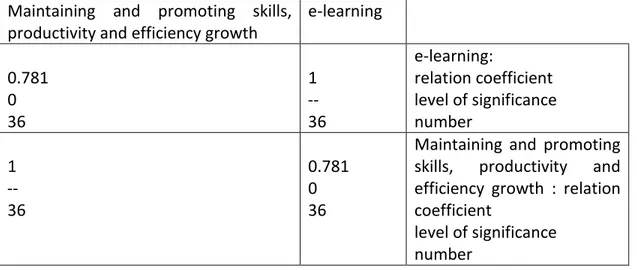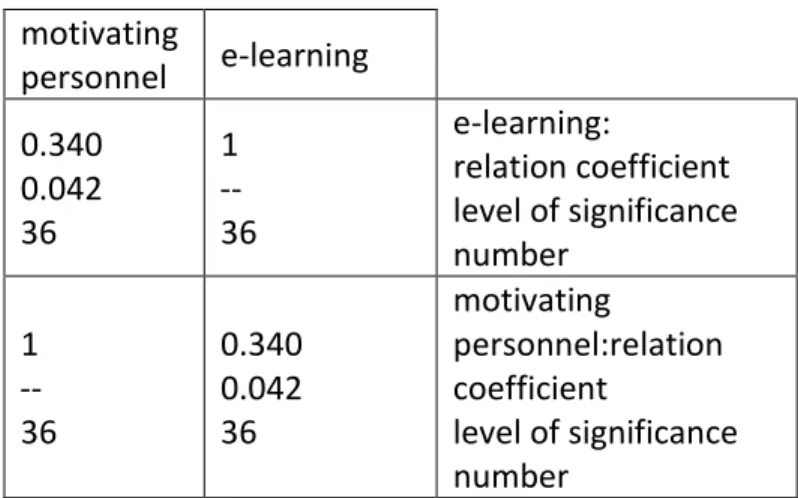550 www.hrmars.com/journals
E-learning Role in Promoting Human Resource
Perso el’s Trai i g i the E iro
e t Protectio
Department of North Khorasan
HamidReza Sodagar
Department of Human Science, Bojnourd Branch, Islamic Azad University, Bojnourd, IRAN IRAN
Dr. Roya Afrasyabi
Department of Human Science, Bojnourd Branch, Islamic Azad University, Bojnourd, IRAN IRAN
Dr. Hashem Asgarzade
Department of Human Science, Bojnourd Branch, Islamic Azad University, Bojnourd, IRAN IRAN
Abstract
The aim of this research is to identify E-lea i g ole i p o oti g hu a esou e pe so el’s training in the environment protection department of North Khorasan in 2012. The main hypothesis of this research is: there is a significant relation between E-learning and promotion
of hu a esou e pe so el’s t ai i g i the depa t e t of e i o e t p ote tio of No th
Khorasan. To this end, E-learning is investigated as independent variable and promotion of human resource pe so el’s t ai i g as depe de t a ia le. This esea h is a applied research in terms of aim, research methodology is descriptive and of relation kind. Statistical universe includes all personnel of the department of environment protection of North Khorasan and since the whole statistical universe has been investigated, sampling method is not utilized.
Resea he ’s uestio ai e has ee used to olle t i fo atio . “P““ soft a e a d the
descriptive and inferential statistics have been used for statistical analysis. Research findings show that there is a direct relation between E-learning and promotion of human resource training. Secondary outcomes indicate that there is a relation between E-learning and on-job training, e uits’ t ai i g ou ses, maintai i g a d p o oti g pe so el’s skills, pe so el’s productivity growth and increased efficiency, between creating new opportunities by E-learning and motivating personnel and preparing them to qualify senior jobs.
Keywords: Human resource promotion, E-learning, Personnel skills and Productivity growth.
Introduction
551 www.hrmars.com/journals
before starting to work. In this idea human spent some time for training and then set out to work life and there was no longer time for training. Currently, this thguoht in universal society and various arenas has no position and training has become an integral part of human existence. Every organization in order to achieve its objectives needs active and flexible personnel in a wide range of circumstances. When an organization tends to implementing dynamic training systems and human force improvement systems, human force will find flexibility in different circumstances of the organization. In other words, training and improvement is an efficient action from organization management to enhance organization
e e s’ o pete e le el. No ada s, hu a fo e is the most important productive agent. In the current world effective human resource in this matter has the main effect. Effective human resource leads to increased capital, exploiting various resources of society and increasing creation and production and ensure advancing society toward national development. Supervisors of different departments of the organization are main respondents for promoting
o ga izatio ’s positio . O e of the ai a s to this e d is to ele ate pe so el’s k o ledge
level. Supervisors believe that training courses like E-learning or on-job training can develop appropriate knowledge, skill and attitude capabilities in personnel.
The Importance and Necessity of the Research
Nowadays, new information and communication technology has changed the nature of knowledge. Learners are expected to produce information rather than using it, in other words applying IT in training and research has become a necessity and one-sided and non-interactive approaches between personnel and senior management and/or student and the education system have been replaced by methods resulting in direct, objective and first-hand learning. Unfortunately, lack of skills in producing new training material along with lack of facilities and technological instruments in most of offices and governmental institutions or training organizations have resulted in survival of traditional training methods in these centers and this problem can impose significant damages to scientific and economic body of the country. Increasing requirements of people to training, their inaccessibility to training centers, lack of economic facilities, lack of experienced trainers and the great costs spent in training led researchers to invent new methods with the help of IT, which are both economical and high-quality and can be applied for a great number of learners simultaneously. Electronic Literacy Movement has been discussed as a solution for transiting to information society rather than conventional literacy; however its implementation is among the most educated people rather
tha a o g illite ates. It is atu al that the ou t ’s edu atio s ste a d o ga izatio s a e
552 www.hrmars.com/journals
on the other hand, traditional training approaches, because of interference with working hours or resting times of the personnel, and also characteristics like one-sidedness and
non-i te a tnon-i non-it a d thenon-i lo ualnon-it , e jo a lnon-ittle el o e a d thus does ’t ha e e ough
efficiency. This research has been conducted to investigate the relation between E-learning and
p o otio of hu a esou e pe so el’s t ai i g i this depa t e t.
The Main Hypothesis
There is a significant relation between E-learning and promotion of human resource
pe so el’s t ai i g i the e ironment protection department of North Khorasan.
The Secondary Hypotheses
1- There is a relation between E-learning and on-job training of personnel in the environment protection department of North Khorasan.
2- There is a relation between E-learning and perso el’s t ai i g ou ses i the environment protection department of North Khorasan.
3- There is a relation between E-lea i g a d ai tai i g a d p o oti g pe so el’s skills in the environment protection department of North Khorasan.
4- There is a relation between E-lea i g a d pe so el’s p odu ti it a d effi ie growth in the environment protection department of North Khorasan.
5- There is a relation between creating new opportunities by E-learning and motivating personnel in the environment protection department of North Khorasan.
6- There is a relation between E-learning and preparing personnel for qualifying senior jobs in the environment protection department of North Khorasan.
Theoretic Definitions of the Terms
E.l: is a concept implying the use of information and communication technologies in training
p o ess. I othe o ds, t ai i g ou se’s o te t is p ese ted th ough usi g te t, oi e a d
video transference to the learner in order to hold training courses in the highest level from every place and in every time utilizing a two-sided connection between learners and teachers and learners themselves. E-learning is presented as synchronous courses and asynchronous courses. In synchronous training all the users are in connection directly but through technology tools like chat, videoconference and virtual classes. While in asynchronous training, like connection through content, councils, assignments, and E-mail, training association is established tardy.
553 www.hrmars.com/journals The Operational Definitions of the Terms
El: is the grade which people and personnel in the environment protection department of North Khorasan gain from answering questions number 1 to 25 in the questionnaire of E-learning.
Promoting human resource training: is the grade which people and personnel in the environment protection department of North Khorasan gain by answering question number 1 to 29 in the questionnaire of promoting human resource training.
Research Background
Mahboobe Talemie (2010) i he Maste ’s Thesis i Meh -e Alborz institute of higher education
has add essed to this issue: i estigati g ke age ts i su essful i ple e tatio of E-learning in Eghtesad-e No i Ba k i Teh a . I this esea h ke age ts a e lassified i se e g oups including organizational agent, technology, beneficiaries, informational gain, methods and approaches, training resources and environmental agents, then the research questionnaire has been distributed among managers, assistants and bosses of central headquarter and bosses of Eghtesad-e Novin Banks in Tehran and the collected information has been analyzed. In
p io itizi g i di es o the asis of espo ds’ ea , access to high speed internet (broadband) was the first priority, informational gain the second priority, necessary skill in producing training program was the third priority, creating culture for developing E-learning and supporting senior managers, existence of an appropriate infrastructure for ICT in the country
a d e plo ees’ skill i usi g o pute a d I te et, a ess to t ai i g a age e t s ste
and mixed training were the next priorities.
Broomand and Ranjbari (2009) in a research tended to investigate “t ategi A tio s of Hu a Resource Management and Innovation Performance with an Emphasize on Knowledge
Ma age e t Role . The esults sho ed that st ategi a tio s of hu a esou e a age e t
had a positive relation with knowledge management capacity. Strategic actions of human resource management are useful and effective for motivating personnel toward achieving, sharing and applying knowledge in organizations. Appropriate strategic actions of human resource management can support and promote organizational environment that helps knowledge management activities. As such, knowledge management capacity has an effect on the relation between strategic actions of human resource management and the performance of innovation.
In 1995 Mac Duffie, in order to indicate innovative actions of human resource, used four metrics and indices, including employment, payment, and promotion and training barriers, in
i estigati g the effe ts of i o ati e a tio s of hu a esou e o the o ga izatio ’s
554 www.hrmars.com/journals
incentive payments, employment and selection, team work, flexible work trends, employment assurance, communication and training. Their results indicated that these innovative work activities, compared to traditional view, like describing limited jobs, hard and inflexible working trends, and hour-based payment with careful monitoring lead to higher productivity levels. Additionally, Youndt et al. (1996) using four aspects of human resource management activities including recruitment, training, performance assessment and payment showed that the system of human resource management activities has a direct relation with multi aspects of performance.
The Research Conceptual Model
Diagram 1: The Research Conceptual Model
Research Methodology
Present esea h’s ethodolog is su e a d i te s of ai is a applied o e. “tatisti al universe in this research are the personnel of the environment protection department of North Khorasan. In this research instead of sampling method, census method is used and all the personnel of the environment protection department are investigated. The number of the statistical universe of the environment protection department of North Khorasan is 36.
The Information Gathering Method
555 www.hrmars.com/journals The Statistical Analyzing Method
In the present research descriptive methods including: frequency distribution tables, descriptive diagrams and central indices (like: mean and median) and dispersion indices (like: standard deviation and varia e) a e used. I the i fe e tial statisti s Pie so ’s elatio test is used, which is done via SPSS data analyzing software. Because both variables have continuous
a d elati e s ales Pie so ’s elatio oeffi ie t as used i this esea h.
Deceptive Statistics of the Research Data
In this research, descriptive statistics is used for summarization on the collected data and further recognition of the statistical universe. Obtained information from the statistical universe is presented in 1-6 tables.
Table 1 and 2: Distribution of learners in terms of gender and age respectively
Pe so el’s
age number frequency Accumulativ e frequency gender number frequency Under 30 6 16.67 16.67 female 14 39.89 30-40 26 72.22 89.89 male 22 61.11 40-50 4 11.11 100 Above 50 0 0 100
Table 3 and 4: Distribution of learners in terms of education and working experience respectively Working experience number Frequency Accumulative frequency degree number Frequency Accumulative frequency
556 www.hrmars.com/journals The Rate of Human Resource Training Promotion
Table 5: Descriptive statistics of promoting human resource training
max mi n
Standard
deviation median mean sum Variable
97 69 6.520 79 80 2880 Promotion of human resource training
16 9 1.81 13 12.88 464 On-job training of personnel 19 14 1.40 17 16.58 597 Pe so el’s t ai i g ou ses
18 11 1.78 13 13.27 478
Maintaining and promoting skills, productivity and efficiency growth
15 8 1.67 11 11.25 405 Motivating personnel
32 21 2.81 25 26 936 Preparing personnel for qualifying senior jobs
Descriptive statistics about human resource training promotion are presented in Table 5 briefly. Total (2880), mean is calculated 80, with a median of 79 and standard deviation of 6.520 and a minimum of 69 and a maximum of 97.
The Rate of E-learning
Table 6: Descriptive statistics of E-learning variable
max min Standard
deviation median mean sum Variable 93 53 9.462 68.5 68.3 2459 e-learning
Also, descriptive statistics about E-learning are presented in Table 6 briefly. Total (2459) mean is calculated 68.3, with a median of 68.5 and standard deviation of 9.462 and a minimum of 53 and a maximum of 93.
Analyzing and Measuring the Hypotheses
The main hypothesis: In the present research the main hypothesis was:
There is a significant relation between E-learning and promotion of human resource
557 www.hrmars.com/journals
To test the existence of a relationship between E-learning and promotion of human resource
t ai i g Pie so ’s elatio oefficient is used. According to Table 7, the correlation coefficient between E-learning and promotion of human resource training is 0.752 and its level of significance is 0 which is smaller than 0.01. Therefore the existence of a relation between E-learning and promotion of human resource training is approved with 99% level of significance and given the fact that the relation coefficient is positive it can be concluded that personnel which are trained by E-learning has a higher promotion of human resource training.
Table 7: Relation coefficient (E-learning vs. promoting human resource training)
E-learning promoting human
resource training
e-learning:
relation coefficient level of significance number
1
--36 0.752
0 36
promoting human resource training:
relation coefficient level of significance number
0.752 0 36 1
--36
The First Secondary Question
There is a relationship between E-learning and on-job training of personnel in the environment protection department of North Khorasan.
558 www.hrmars.com/journals Table 8: Relation coefficient (E-learning vs. On-job training of personnel
e-learning On-job training
of personnel
e-learning:
relation coefficient level of significance number
1
--36 0.338
0.044 36
On-job training of personnel:
relation coefficient level of significance number
0.338 0.044 36 1
--36
The Second Secondary Question
There is a relationship between E-learning and perso el’s t ai i g ou ses i the e i o e t protection department of North Khorasan.
Based on the data obtained from Table 9, the relation coefficient between E-learning and
pe so el’s t ai i g ou ses is 0. 0 a d its le el of sig ifi a e is 0.0 . A d because level of significance is smaller than 0.05, therefore we can say that there is a relation between
E-lea i g a d pe so el’s t ai i g ou ses ith 9 % le el of sig ifi a e.
Table 9: Relation coefficient (E-lear i g s. e perso el’s trai ing courses)
e-learning
e pe so el’s
training courses
e-learning:
relation coefficient level of significance number
1
--36 0.340
0.043 36
e pe so el’s t ai i g
courses: relation coefficient level of significance
number 0/340
0.043 36 1
--36
The Third and Fourth Secondary Question
559 www.hrmars.com/journals
According to the data obtained from Table 10, the relation coefficient between E-learning and
ai tai i g a d p o oti g pe so el’s skills effi ie g o th a d i eased p odu ti it is
0.781 and its level of significance is 0. And because level of significance is smaller than 0.1, therefore we can say that there is a relation between E-learning and maintaining and
p o oti g pe so el’s skills effi ie g o th a d i eased p odu ti it ith 99% le el of
significance.
Table 10: Relation coefficient (E-learning vs. Maintaining and promoting skills, productivity and efficiency growth)
e-learning Maintaining and promoting skills,
productivity and efficiency growth
e-learning:
relation coefficient level of significance number
1
--36 0.781
0 36
Maintaining and promoting skills, productivity and efficiency growth : relation coefficient
level of significance number
0.781 0 36 1
--36
The Fifth Secondary Question
There is a relationship between creating new opportunities by E-learning and motivating personnel in the environment protection department of North Khorasan.
560 www.hrmars.com/journals Table 11: Relation coefficient (E-learning vs. motivating personnel)
e-learning motivating
personnel
e-learning:
relation coefficient level of significance number
1
--36 0.340
0.042 36
motivating
personnel:relation coefficient
level of significance number
0.340 0.042 36 1
--36
The Sixth Secondary Question
There is a relation between E-learning and preparing personnel for qualifying senior jobs in the environment protection department of North Khorasan.
Based on the data obtained from Table 12, the relation coefficient between E-learning and preparing personnel for qualifying senior jobs is 0.729 and its level of significance is 0. And because level of significance is smaller than 0.1, therefore we can say that there is a relation between E-learning and preparing personnel for qualifying senior jobs with 99% level of significance.
Table 12: Relation coefficient (E-learning vs. preparing personnel for qualifying senior jobs)
e-learning Preparing personnel for
qualifying senior jobs
e-learning:
relation coefficient level of significance number
1
--36
**0.729
0 36
Preparing personnel for qualifying senior jobs: relation coefficient
level of significance number
0.729
0
36 1
--36
The Results Obtained From Hypothesis Testing
561 www.hrmars.com/journals also a o g p o otio of hu a esou e t ai i g o po e ts, pe so el’s eadi ess fo ualif i g se io jo s, oti ati g pe so el, e uits’ t ai i g ou se, ai tai i g a d p o oti g pe so el’s skills efficiency growth and increased productivity and on-job training of personnel gained the highest grade in realizing E-learning, respectively.
Also, given the data extracted from questionnaire, the following results obtained:
Most of the subjects (about 72.22%) were 30-40 years old. Most of the subjects (about 61.11%) are male.
Most of the subjects (about 50%) have the Bachelor degree.
Most of the subjects (about 69.44%) have 5-10 years working experience.
Based on the research findings researchers can infer that
Among promotion of human resource training components, pe so el’s ai tai i g a d
p o oti g skills, pe so el’s effi ie g o th a d i eased p odu ti it , pe so el’s
readiness for qualifying senior jobs, motivating personnel, rec uits’ t ai i g ou se, a d o -job training of personnel have gained the highest relation coefficient with E-learning, respectively.
Research Limitations
Among the limitations of this research are place and time limitation; that is, the research has been merely implemented in North Khorasan in 1390-91. This research is of relation kind and in this research method we cannot understand casual relationships and only we can realize existence or non-existence of a relationship and its intensity. Meanwhile, because of time limitation only questionnaire has been used and other methods like interview and observation are not utilized. As such, some respondents had positive or negative attitudes toward the organization (the environment protection department of North Khorasan), and it is tried to help actualizing the answers by mentioning open ended questions and by providing some practical strategies. In addition, lack of similar researches concerning promotion of human resource training and absence of a research in the field of the conducted study, faced resource collecting with some difficulties.
Suggestions Based on the Research Findings
According to the results obtained from Hypothesis testing, it is suggested that the platform for using E-learning should be provided in on-jo t ai i g of pe so el i o ga izatio s, i e uits’
t ai i g ou ses, i o de to ai tai a d p o ote skills a d also pe so el’s effi ie g o th
and increased productivity, in motivating personnel, in preparing personnel for qualifying senior jobs and also in line with promoting human resource training.
In addition, investigating the relation between E-learning and promotion of human resource
pe so el’s t ai i g i othe o ga izatio s o a d also i the e t ea s a d afte fu the
562 www.hrmars.com/journals
Among other cases for review are identifying the barriers of E-learning application in organizations.
Persian References
Abbaspoor, A. (1388). Human Resource Management: Trends, Processes, Applications, Tehran, Samt Publications.
Abbas, Z.; Mohammad, S.; Zadeh, T.; Jafar. (1379). Evaluation of Training Needs in Organizations, Enteshar Stock Company, Tehran.
Abili, K. (1384). Statements of Evaluation Lesson, MA Thesis, Tehran, Educational Science College of Tehran University.
Abtahi. and Hasan, S. (1366). Concept, Features and Problems of Staff Training, Governmental administration, First Number
Abtahi. and Hasan, S. (1383). Training and Improving Government's Human Resource, Institute of Training Studies and Panning, Tehran, Publications of the Iran's Development and Rehabilitation Organization, pp 23-24
A esso of the Cou t ’s Ma age e t a d Pla i g. (1382). Training and Improving Gove e t’s Hu a Fo e, Pu li atio : O ga izatio of Cou t ’s Ma age e t a d Pla i g Ahadian, M. (1382). Training Technology Preliminaries, 25th Edition, Tehran, Bashari Publications and Advertising, pp 20
Anderson, T. and Elomi, F. (1385). E-learning from Theory to Action, Translation: Zamani and Azimi. Publications of Intelligent School's IT development Institution, pp 27
ArabMazar, Y. Mohammad, Azadmanesh, Nahid. (1382). Adult E-learning: Which Options and Interest. Tehran, Salmand House of Culture.
Bazaz Jazayeri, seyed Ahmad. (1379). Staff Training as a Known Necessity in Official and Industrial Organizations, Tehran: Governmental Administration Training Centre. pp 42137 Badvi, M. K. (1379). Educating Managerial Skills of Engineers and Researchers, Translator: Engineer Mehrdad Taghavi Gilani, The Office of the Studies of Defense Industry Educational and Research Institution, Tehran.
Davudi, Mojtaba. (1390). I estigati g “tude t’s “atisfa tio of E-learning System, MA Thesis of Mehr-e Alborz University
Eliot, S. (1381). Distant-Education Systems, Translation: Dr. Seyed Mehdi Miedamadi, First Edition, Karaj, Agriculture Training Publications
Faragi, Nasrollah. (1389). Research Methodology in Psychology and Educational Sciences, Third Edition, Pooran Pazhoohesh Publications, Tehran, pp 246.
Farhamgi, Ali Akbar and Mahdavi, Abd Al-Mohammad. (1382). Comprehensive Scheme of
T ai i g Need E aluatio fo Ma age s a d “taff of Teh a P o e ie e’s Tele o u i atio
Company, Management Applied Research Centre, Tehran University.
Fathi Vajargah, Koorosh. (1381). Training Need Evaluation (Patterns and Techniques), Aiizh Publication
Hasanzadehm, Ramezan. (1385). Research Methodology in Behavioral Science, Fourth Edition, Savalan Publications, Tehran, pp 98
563 www.hrmars.com/journals
Kargar, Qolamreza. (1389). Hu a Resou e Opti izatio as a “t ateg to O ga izatio ’s “ta le Development, Police Human Development Magazine, sixth Year, Number 24
Khaki, Qolamreza. (1388). Getting Familiar with Productivity Management, Tehran: Cultural Association of Sayeh Nama Publications, Fifth Edition, pp 208
Khosravi, M. and Ebrahimi. (1382). E-Learning in Village, Presented Article in IT and
Co u i atio Appli atio ’s Co g ess i Village, Ele t o i Resea h Ce t e of “ ie e a d
Industry University, Tehran.
Lobof, Maikle. (1382). The Biggest Managerial Factor in the World, Translation: Mehdi,
Iran-ejad Pa izi, Pu li atio s of I a ’s Li a De elop e t Co pa .
Lotfollah Hamedani, Mohammad Hosein. (1381). Success Evaluation Measures of an OrganizationT Tadbir Magazine, Number 121, pp 65
Maikle, A. (1379). Human Resources Management Strategies, Translation: Abilim Khodayar and Movafaghi, Hasan (1380). Farda Publication.
Movahed. Mohammadi, H. (1381). The role of Internet Information Network and Web on Training- Research Activities of MA Students in Agriculture Colleges, PHD Thesis, Agriculture College, Tehran University, pp 15
Rezaiian, Ali. (1380). Organizational Behavior Management, Tehran, Second Edition, pp 27 Ranjbari, Maryam, Broomand, Mojtaba. (1388). Strategic Actions of Human Resource management and Its Performance and Innovation with an Emphasis on Knowledge Management Role, Human Development Magazine, Sixth Year, Number 24
Sabbaghian, Zahra and Akbari, Soheilia (1389) Organization Comprehensive Training (ith a trand toward Adult Learning) Tehran: Organization of University Human Scie e Books’ “tud a d Development (Samt) pp 628
Seyed Javadian, Seyed Reza. (1375). Human Force Planning, Publication of Management College, Tehran University, second Edition, Tehran.
Seyf, Ali-Akbar. (1387). Modern Educational Psychology, Sixth Edition, Doran Publications. Semon, L.; Dola, Rendal, Shoer, S. (2000). Staff Affairs and Human resource Managementm Translation: Dr. Mohammad-ali Toosi and Dr. Mohammad Saebi, Publication: Governmental Administration Training Centre, Year of Publication: 1377
Shabli, K. (1376). Determining Training Needs of Managers and Staff in Dynamic Organizations, Tadbir Magazine, Number 79, 1376
Shariatmadari, M. (1386). Essence and Role of Training in Promoting Human Force and Development in the Third Millennium
Shams Al-dini, S. (1386). Training and Research Office in a Glance.
Taheri, Shahnam. (1390). Productivity and its Analysis in Organizations (Comprehensive Productivity Management) Tehran: Hastan, First Edition, pp 390
TabaTabaii, Ahmad, S. (1383). Training System and Government Staff, Accessory of Human Capital And Management Development.
Zareii Zavaraki, Ismail, Safaii, Movahed, Saeed. (1384). E-learning in 21th Century, Tehran, Science and Technic Publications, Tehran University.
Zareii, Hasan. (1384). Strategic Planning for Strategic Resources, Management Knowledge quarterly, Tehran University.
564 www.hrmars.com/journals
Zamani, Qolamhosein and Moghadasi, Shahram. (winter 1376 and spring 1377). Distant Education, an Alternative Strategy in Staff Training, Management Knowledge Quarterly, Year 11, Number 39 and 40.
Latin References:
Alharthi, Mohammad, A. (2003). A High quality portal frame work for asynchronous learning networks: intellectual capital aggregation and organization, doctorate thesis, Vanderbilt university.
Aldershot, Hampshire. (2004). Gower handbook of training and development.
Armstrong, Amy Jo. (2002). An investigation of personal – social contextual factors of the online adult learner: perceived ability to complete and succeed in a program of study. Doctorate Thesis, Virginia commonwealth university
Ausubel, D.P. (1960). The use of advance organizers in the learning and retention of meaningful verbal material. Journal of educational psychology, 51, 267-272.
BARLEY. (1996). THE NEW WORLD OF WORK. PAMPHLET, BRITISH-NORTH AMERICAN COMMITTEE, LONDON"
Cooper, R. ( 2004). E-learning in the World.London: Falmer
Clark,R. E. (1983). Reconsidering research on learning from media. Review of educational research, 53(4), 445-459.
Cole, R. A. (200). lssues in web-based pedagogy:a critical primer. westport, ct:greenwood press. Capua, D.; Andrea. & Wintergerst. (2005). Assessing and validating a learning styles instrument, System 33.
Decenzo, D. A. & Robbins S. P. (1988). personnel/human resource management: third edition, prentice-hall
Dessler, G. (1998). Personael management. fourthe edition. prentice – hall. Eklound, P. (2005). Adapting to the Information Age. Berlin: Pen.
Robert, F. (2007). The effect of friendship and the relationship dimensions of the classroom, Good, T. L., & Brophy, J. E. (1990). Educational psychology: A realistic approach (4th ed). White plains,ny: longman.
